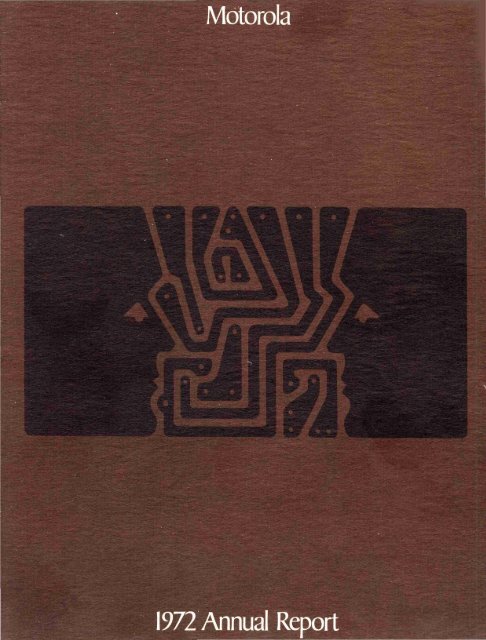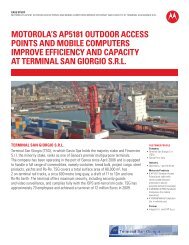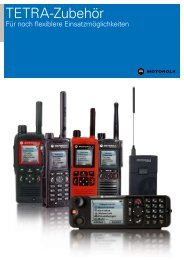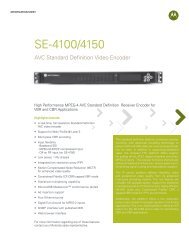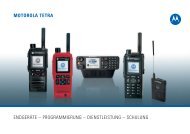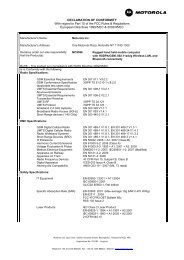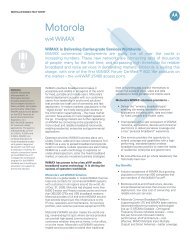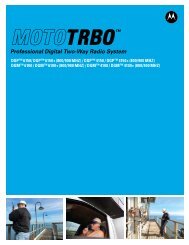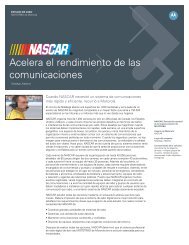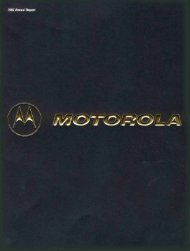Motorola 1972 Annual Report - Motorola Solutions
Motorola 1972 Annual Report - Motorola Solutions
Motorola 1972 Annual Report - Motorola Solutions
You also want an ePaper? Increase the reach of your titles
YUMPU automatically turns print PDFs into web optimized ePapers that Google loves.
<strong>Motorola</strong><strong>1972</strong> <strong>Annual</strong> <strong>Report</strong>
The mind to imagine... the skillto do.This year's annual report celebratesthe dynamic spirit thatunites <strong>Motorola</strong> people and theircustomers in a global network ofperformance. The men andwomen who create, produce andsell our products share conscientiouslyin the task of applying innovativetechnology to help serveincreasingly complex humanneeds around the world. In appreciation,we dedicate this book tothem.
To Our Shareholdersand Friends<strong>1972</strong> was a banner year for <strong>Motorola</strong>. We are pleased to report thatsales and earnings in every quarter, and for the full year, established recordsfor each such period. The sales and earnings performance of everydivision increased substantially over 1971. Our earlier stated expectationsof generally firming worldwide economic conditions and consistently improving<strong>Motorola</strong> results did materialize.Sales volume for the year broke through the billion dollar level, withsales and other revenue of $1,163,315,088 being up 26% from 1971's$926,592,871. Earnings increased at an even greater rate-$52,038,120compared with $31,749,944-up 64% from 1971. Earnings per share of$3.81 compared with $2.37 the previous year.Each of our five divisions participated in reaching this milestone in thecompany's history. Major achievements of each division are detailed inthe main body of this report. Progress made by our New Ventures groupand the electronic watch components groups have also kept pace with ourexpectations.Financial. <strong>Motorola</strong>'s financial position remains strong and is markedby a current ratio of $2.23 of current assets to every dollar of current liabilities.Consolidated worldwide long-term debt is at a low 15% of long termdebt plus shareholders' equity. Fixed asset expenditures in <strong>1972</strong> were $48million, compared with $32 million in 1971. Our current plans for 1973provide for a sharp increase in such spending, to approximately $80 million.This large increase, which includes major projects initiated in <strong>1972</strong>, isa function of: (1) the rapid growth in our business which has occurred overthe past few years; (2) the simultaneous maturing of several major internationalbusiness plans; and (3) the fact that some fixed asset expendituresnormally anticipated for the 1970-72 period were deferred pending clearindication of the economic recovery which has now taken place.Research and development spending was $76 million, up from $65million in 1971. A further increase is planned for 1973.The large fixed asset expenditures, increased R & D spending and theadditional working capital needed to support continued sales growth in1973, while significant in amount, are not expected to require equity financingin the foreseeable future. Our major sources of funds continue tobe retained earnings and depreciation. <strong>1972</strong> depreciation was $30.5 million,up from $27.2 million in 1971. 1973's depreciation is expected toadditionally increase as a consequence of greater fixed asset expenditures.Share distribution. In February 1973, the <strong>Motorola</strong> Board of Directorsexpressed its intention to effect a share-for-share distribution on or aboutJune 1 to shareholders of record on or about May 18 subject to shareholderapproval at the May 7 annual meeting of a proposal to increase the numberof authorized shares of common stock of <strong>Motorola</strong> from 20,000,000 to40,000,000. Also, the board expressed its intention to raise the quarterlydividend in June to 12.5 cents per share then outstanding. This would beequivalent to a 66%% increase in the present annual dividend rate. If thenew dividend rate is adopted and maintained during the remainder of1973, cash dividends paid in 1973 would be equivalent to 80 cents pershare on the presently outstanding shares and would be within the guidelineestablished by the U.S. Committee on Interest and Dividend whichpermits aggregate dividend payment inl973 not exceeding 25% of <strong>1972</strong>net income. Continuation of the increased dividend would naturally dependon our operating results and financial position as well as on thencurrent government regulations or guidelines at any given time.Delaware reincorporation. The 1973 annual meeting proxy materialwhich will be mailed on or about March 29 will also contain a proposal
adopted by the board of directors on February 28, to reincorporate <strong>Motorola</strong>as a Delaware corporation. This proposal results from an extensiveand detailed study by the board and legal counsel. Under the rules of theSecurities and Exchange Commission governing the solicitation of proxiesit would be inappropriate to describe the terms of the proposed reincorporationhere; however, all details concerning this proposal, including afull statement of the board's reasons for adopting the proposal, will beincluded in the proxy material which will be mailed to shareholders shortly.Management and organization. The organization change we implementedin early <strong>1972</strong>, and which we detailed in last year's shareholderreport, is enabling us and our key associates to provide operational leadershipto our rapidly growing businesses and simultaneously to devote moreattention to the key issues and opportunities the company will face in the1970s.As long planned, Elmer H. Wavering, previously vice chairman andchief operating officer, retired December 31 from these positions aftercompleting more than 41 years of <strong>Motorola</strong> service and upon reachingthe age of 65. It is impossible in the limited space of this letter to even mentionMr. Wavering's many contributions to <strong>Motorola</strong>'s successes over thepast four decades, or to adequately state the appreciation of ourselves andour associates for those contributions. We do gratefully acknowledge Mr.Wavering's magnificent service to the company and express our pleasurethat he will remain a member of the board of directors.International trade and investment. Elsewhere in this report is includeda commentary on international trade and investment. Since we recognizethis issue to be of vital national concern, we want to communicate to allshareholders the company's position in this regard.Outlook. Because of the fine results achieved in <strong>1972</strong>, it should not beexpected that the magnitude of year-to-year comparisons will continue.However, as we enter 1973, we find the level of bookings, backlog andbillings to be firm. This, along with the generally optimistic domestic andinternational economic outlook, supports our expectations of further increasesin sales and earnings in all divisions in 1973.<strong>1972</strong>'s record results and the passing of the billion dollar milestonecould not have been achieved without the splendid efforts of all membersof the <strong>Motorola</strong> family worldwide, efforts which we do acknowledge withsincere gratitude.For the Board of Directors,Chairman of the BoardPresidentMarch 20, 1973
Financial Highlights<strong>1972</strong> 1971Sales and Other Revenues $1,163,315 $926,593Income Before United States, Canadaand Other Nations'Income Taxes 92,462 62,055% to Sales 7.9% 6.7%United States, Canada and OtherNations'Income Taxes 40,424 30,305Earnings 52,038 31,750%toSales 4.5% 3.4%Per Share of Capital Stock 3.81 2.37Weighted Average Shares Outstanding 13,648,443 13,410,794Capital Expenditures 48,008 31,977Depreciation 30,529 27,239Working Capital 311,587 247,579CurrentRatio 2.23 2.22Shareholders' Equity 439,611 375,897Book Value Per Share 31.89 27.88Yearend Employment (approx.) 56,000 49,000Dollar amounts in thousands, except per share data<strong>Annual</strong> Meeting. The annual meeting will be held on Monday, May 7,1973. A notice of the meeting, together with a form of proxy and a proxystatement, will be mailed to shareholders on or about March 29, 1973, atwhich time proxies will be solicited by management.Transfer Agents Harris Trust and Savings Bank, 111 W. Monroe St.,Chicago, 111. 60690First National City Bank, 111 Wall St., New York, N.Y. 10015Registrars Continental Illinois National Bank and Trust Company of Chicago,231 S. LaSalle St., Chicago, 111. 60690Irving Trust Company, 1 Wall St., New York, N.Y. 10015Auditors Peat, Marwick, Mitchell & Co., 222 S. Riverside Plaza, Chicago,111. 60606.
ContentsLetter to Shareholders 1Financial Highlights 3Directors and Officers 5Communications Division 6Semiconductor Products Division 8Consumer Products Division 10Government Electronics Division 12Automotive Products Division 14New Ventures Activity 16Other Businesses 17International Trade and Investment Statement 18Major Facilities and Product Lines 19Financial Statements 20Ten Year Financial Summary 28
OfficersDirectorsAGEYEARSOFSERVICEROBERT W. GALVINChairman of the Board and Chief Executive Officer50 32ROBERT W. GALVINWILLIAM J. WEISZPresident and Chief Operating Officer46 25BENJAMIN W. BORNEVice President, Human Relations48 1J.PAUL JONESALLEN H. CENTEREDWARD J. HARTYVice President, Public RelationsController60 1957 21OSCAR P. KUSISTOJOHN T. HICKEYJOHN A. HUBENYDONALD R. JONESJ. PAUL JONESSTEPHEN L. LEVYVice President for Finance and Secretary47 25Vice President and Assistant to the Chief Financial Officer 62 38Treasurer 43 22Vice President and Director of Corporate Staff 49 21Vice President, New Ventures 51 9STEPHEN L. LEVYHOMER L. MARRSARTHUR C. NIELSEN, JR.HOMER L. MARRSWALTER B. SCOTTVice President and General Manager, Equipment Divisions 56Vice President and Director of Manufacturing and Facilities 573527LEWIS D. SPENCER Vice President and General Attorney56 22COMMUNICATIONS DIVISIONJOHN F. MITCHELL Vice President and General Manager45 20ARTHUR L. REESEELMER H. SCHULZWALTER B. SCOTTCARL E. LINDHOLMMARTIN COOPERJACK GERMAINVice President and Assistant General ManagerVice President and Director of Systems OperationsVice President and Director of Product Operations44444661923EDWIN P. VANDERWICKENChairman, Financeand Audit CommitteesJOSEPH F. MILLERVice President and Director of Domestic Distribution4821ELMER H. WAVERINGROBERT N. SWIFTVice President and Director of MarketingSEMICONDUCTOR PRODUCTS DIVISION4921WILLIAM J. WEISZTHOMAS J. CONNORSJOHN R. WELTYVice President and General ManagerVice President and Assistant General Manager4350915KENNETH V. ZWIENERCHRISTIAN J. GOODMAN Vice President and Director of Division Staff5211JACK C. HAENICHENVice President and Director of Operations, MOS3714PATRICK D. LYNCHVice President and Director of Operations, Bipolar ICs39 13CONSUMER PRODUCTS DIVISIONEDWARD P. REAVEY, JR. Vice President and General Manager49HERBERT D. DeBORDEVice President, Operations53GOVERNMENT ELECTRONICS DIVISIONRALPH W. ELSNERVice President and General Manager52 24AUTOMOTIVE PRODUCTS DIVISIONOSCAR P. KUSISTOJAMES A. TORRENCEFRED P. HILLVice President and General ManagerVice President and Assistant General ManagerVice President and Director of Entertainment Productsand International Operations59 2442 2052 34Director Emeritus:DANIEL E. NOBLEChairman,Science Advisory Board
Communications DivisionDivision sales and earnings reached record highs.Sales increase exceeded the long term growth rate and theprofit margin improved over the previous year.New order for Metrocom system was placed by MarylandDepartment of Transportation for Baltimore. Communicatesvoice messages, automatic status reports and emergencyalarms from public transport vehicles to dispatchers.Fort Lauderdale Police Department purchased a TotalArea Coverage (TAC) system of personal portable radios andsolid state modular communications control centers. Police officerscommunicate via personal portable radios to their dispatchersfrom anywhere within the city.Computer-aided dispatch vehicle status system was purchasedby the police department in Huntington Beach, Calif.The system is designed to enable police to command and controltheir vehicles more efficiently in emergency situations.New Motorcall system bought by Florida State Departmentof Transportation. This system is designed to help strandedmotorists summon aid through roadside radios.'72 product introductions: A new line of UHF Micormobile radios and medium power base stations to complementexisting models, and a low frequency, 100-watt version of theMocom-70 mobile radio were added. Personal radio highlightsincluded the Handie-Com MH 10 two-way portable radio inVHF band and the Pagecom pager as economy models to supplementthe existing Handie-Talkie portable radio and thePageboy II pager line. Modcom, modular communicationscontrol console, a desk top communications center, also introduced.Coronary Observation Radio (COR), a mobile telemetryunit which monitors cardiac functions, was introduced forambulance and medical personnel.Continued upward trend in international sales: Canadacontinued service to public safety markets in Edmonton,Hamilton and Windsor with expanded mobile and portableradio systems. Spanish telephone company made a majorPageboy II purchase. The Royal Netherlands Air Force orderedlarge quantities of UHF radios and pagers. French taxi systemplaced a major order for mid-band radios. '72 brought increasedEuropean acceptance of paging systems and mobileradios.Order input growth is on target in other world markets.Argentine federal police placed a large equipment order in '72.Expanding markets for reliable communications equipmenthave emerged in Africa, Middle East, Latin America and in theAsia/Pacific area.Current trends of order input and backlog indicate furthergrowth in world markets and greater sales volume for thedivision.Alone in a city of strangers, awoman waits. After dark theempty streets add fear to herloneliness. But unknown to her,strangers are helping to make herworld a safer place through bettercommunications —
... In <strong>Motorola</strong>'s Schaumburg, 111.plant, Neysa Thompson supervisespeople who assemble Micortwo-way radios. Solid state, modularconstruction has replacedvacuum tubes with easy to installcircuit boards. Neysa and herpeople are dedicated to meetingthe quality standards set by <strong>Motorola</strong>engineering.Besides Neysa, another strangeris watching out for the waitingwoman's safety. Every eveningOfficer Hammond's patrol takeshim past streets where lonelycrowds hurry by. His police car,equipped with Micor radio communications,is in constant contactwith a citywide network ofpolice patrols. Like the men inhundreds of law enforcementagencies across the country, OfficerHammond depends on hisMicor radio for its advanced performancecapabilities.<strong>Motorola</strong> communicationstechnology brings strangers togetherand helps them help eachother. And that's good to knowwhen a woman must wait aloneafter dark.
.t ^
SemiconductorProducts DivisionW
"Pete, my printout from theSTARS system this morningshows a backorder on thoseROMs I ordered yesterday. Mycustomer can't wait. Can you doanything?" "I'll try, Ralph."Pete Myslinski and Ralph Giessenhave never met. But, twice aday, Pete phones Ralph in SchillerPark, 111. from <strong>Motorola</strong>'s semiconductorCustomer Serviceheadquarters in Phoenix. Ralphworks for Hamilton/Avnet, a toprankednationwide distributor ofelectronic components. As Hamilton'smanager for <strong>Motorola</strong>'ssemiconductor products in theChicago area, Ralph can counton <strong>Motorola</strong>'s Pete and the dailySTARS teletype report to helphim take care of his customers.STARS is a unique, daily orderactivity report system serving<strong>Motorola</strong>'s franchised U.S. distributors.On a coded teletypecommand to the STARS computerin Phoenix, in minutes thedistributor can receive a completeprintout of his previous day'sorders for <strong>Motorola</strong> parts. Forewarnedby STARS, Ralph hadtime to track down most of the<strong>Motorola</strong> ROM integrated circuitshis customer needed fromother Hamilton/Avnet offices.Now the rest was up to Pete."Ralph, I put a priority rush onyour order, and we're getting outa partial shipment immediately."Electronics equipment manufacturersmay not know aboutPete 'n Ralph, or the STARS program.But they do know that their<strong>Motorola</strong> distributor offers themthe same reliability in deliverythat they depend on in <strong>Motorola</strong>semiconductors.
Record high sales and earnings were due to resurgentworldwide demand in most major semiconductor markets.Significant growth factors: the computer markets' revival plusnew applications for discrete semiconductors and integratedcircuits in consumer and industrial electronics. These positivetrends are expected to continue.'72 industry sales were estimated up by about 25% inworldwide semiconductor market. The European marketgrowth was estimated to be 20-25%; Asia/Pacific, 19-22%;and U.S. domestic about 28%. <strong>Motorola</strong> semiconductor productsalso recorded significant growth in all three markets.MECL 10,000 circuits became a standard logic for computerindustry, with 18 new devices added to this high speedintegrated circuit family in '72. The line now has 37 standardcircuits plus 17 wide temperature functions for military use.Metal-oxide-semiconductor (MOS) integrated circuitsales for <strong>Motorola</strong> during '72 grew at a faster rate than theworld industry, whose growth was an estimated 60-70%. Incomplementary MOS (CMOS), 41 new devices were introduced.Linear integrated circuit sales accelerated well beyondinitial estimates. Further expansion is predicted for '73.A major factor: the automotive market, prompted by new fed -eral safety standards.Sales of discrete semiconductors increased, especiallyin silicon small signal and power transistors. Small signalgrowth was caused largely by the improved entertainmentproducts market, particularly TV receivers. Power transistorsare expected to enjoy strong growth through the mid '70s,primarily due to vital role in "all solid state" TV, portable electronicsand electronic ignition systems. It is doubtful that integratedcircuits will penetrate these high-growth discrete productareas.Production capacity is being increased to meet worldwidesemiconductor demand. A 67,000 sq. ft. plant was completedin East Kilbride, Scotland; and a 62,000 sq. ft. addition,more than doubling the size of the Guadalajara, Mexico plant,will be completed by Fall '73. Increased production space atthe main Phoenix plant will become available upon completionof a 67,000 sq. ft. office building, scheduled for mid '73.Customer service "first" was scored in the industry withthe newly opened "LocaLogic" Design Center in Lexington(Boston), Mass. Eastern area equipment manufacturers areusing the center to design their own complex LSI circuits withouttraveling to the Phoenix design headquarters. More centersare planned.Semiconductor prospects excellent for '73. Total U.S.factory sales are forecast to continue their upward trend, aswill sales in the international markets. <strong>Motorola</strong> is confident ofretaining its share of this industry growth.
ConsumerProducts DivisionColor TV sales set second straight annual record.Unit sales increased (distributor to dealer) by about 40% —nearly double the U.S. industry figure.Black-and-white TV sales climbed 40% in contrast tothe U.S. industry average of about 8%.Continuing trend: Despite shift in demand to portablesfrom color consoles, <strong>Motorola</strong> console sales remained generallyabove industry averages. Portables kept pace with increaseddemand.Strong national advertising program established forQuasar color TV on the three major national television networks— concentrated on college and professional football plusprime time shows.Customer Satisfaction Program to upgrade consumerservice —now fully underway in Wisconsin, Michigan andTexas. Established television set service centers are chosen onthe basis of technical proficiency, employe training programs,availability and maintenance of equipment and parts. Expansionplans are underway for U.S. and Canadian dealers.The division continued to apply video expertise in itsnewly developing visual display business. The displays areused for readouts in computer terminals and closed circuit TVsystems.A major expansion program is closing the gap on increasedproduction requirements. Opened in '71, the Toronto,Ont. color TV assembly plant was enlarged from 45,000 sq. ft.to 65,000 sq. ft. An adjacent facility was leased to provide42,600 sq. ft. of additional production and office space. TheTaiwan plant, also opened in '71, was expanded from 123,000sq. ft. to 161,000 sq. ft. In Quincy, 111., 145,000 sq. ft. wereadded to the original 710,000 sq. ft. plant. Completion is duein '73. In Webb City (near Joplin, Mo.), <strong>Motorola</strong> purchased a38,000 sq. ft. plant and additional land for future expansion.'73 plans call for a 40,000 sq. ft. addition to Webb City plant.The division is reaping benefits of technical leadership.<strong>Motorola</strong> was first to mass-produce color TV receiverswith rectangular picture tubes; first in U.S. with all solid statemodular color sets; and first in the U.S. with five-function, onebuttontuning. Now the only manufacturer offering up-front,"works in a drawer" service accessibility.Excellent showing in Canadian color TV sales. <strong>Motorola</strong>Canada Limited sales, earnings and market share metexpectations. Growing sales penetration is expected in '73with consumer demand reinforced by advertising on CanadianTV networks.10
"When I make my follow-upcalls to customers," says DoloresO'Toole, "I hear comments like —'I didn't believe you were reallyfrom <strong>Motorola</strong> until the servicemancame and fixed our TV set';or, 'imagine a manufacturer caringabout someone who has alreadybought his product!'." Asconsumer coordinator Doloresstarts her workday in the afternoonand stays well into the eveningto reach customers at home.Representing <strong>Motorola</strong>'s customersatisfaction program, shehas telephoned hundreds of peoplewho recently purchased aQuasar color TV to explain thatbuying a <strong>Motorola</strong> product meansthe beginning of a relationship,not the end. Although most of thecustomers she talks to are satisfiedwith their new TVs, if one hasa problem he can depend onDolores to help. Often the onlyservice needed consists of someminor adjustment covered by theQuasar guarantee, whose basicterms are on the back of everycolor TV set.In calling back to make surethat the customer's problem hasbeen solved, Dolores usually findsthe person still a bit astonishedbut appreciative. As <strong>Motorola</strong>'scustomer satisfaction programhas revealed, personal contactand consideration can buildbonds of trust between manufacturerand consumer.
GovernmentElectronics Division• * * • • « • •
In space, a minor malfunctionmay signify a fatal flaw. WhenNASA asked <strong>Motorola</strong> to designand install a device to test a pieceof Apollo equipment not producedby <strong>Motorola</strong>, CullenMoore, senior staff engineer atGED, knew how much could beat stake. Working under a supportcontract with NASA, Cullen'steam had just one week to buildthe unit, ship and install it in a keytracking station outside Madrid,Spain. As Cullen says, to get ascore of people working with totaldedication on a project, you mustfire their imaginations. Give themthe challenge of an "almost impossibletask." Five and one halfdays later, the test equipment,cannibalized from a Block IIApollo lunar module transponder,was on its way. After Cullen andanother <strong>Motorola</strong> engineer madethe final preparations at the Madridstation, the testing devicewas able to produce the data requestedby NASA during the nextflight. The way Cullen Moore seesit, with so much riding on communications,nothing should beleft to chance.Dedicated engineering backedup the <strong>Motorola</strong> communicationsequipment aboard LunarRoving Vehicles, Lunar Modulesand Command Modules thathelped link the Apollo astronautsto Earth. <strong>Motorola</strong> transpondershelped relay TV pictures and biomedicaldata from the astronautsand provided two-way radio contactwith tracking stations aroundthe world.
Sales were up over the previous year and earnings were atan all-time high. Yearend backlog was up more than 60% over'71.Space activity continuing. During '72, division deliveredNASA equipment for manned Skylab program — hardware forearth-to-space communications and the relay unit for the commandmodule's docking with the orbiting Skylab.Development is underway for NASA and the Jet PropulsionLab on three major communication/electronic subsystemsfor the '73 deep space probe to Venus and Mercury.Five subsystems are in preparation for a '75 Viking/Mars unmannedorbiter and lander mission.Contracts awarded in '72 include production of communicationstransponders for Earth Resources TechnologySatellites and the Atmospheric Explorer Satellite. Another is todevelop a transponder for the Smithsonian Institute's Red Shiftrelativity experiment to be orbited by NASA.Development and shipboard tests completed on FleetBroadcast receiving systems. Designed to provide primarysatellite communications for U.S. Navy's major ships. Followonproduction opportunities are significant.Multimillion dollar Defense Department contractawarded to develop secure voice communications for thearmed forces. Initial development was completed on U.S.Army's Position and Survey System (PASS). A new contractwas also received for 20 additional precision PASS sets, usedin mapping and artillery location.In radar development, initial contract was received for thefirst units of <strong>Motorola</strong>'s new Totalscope II visual display device.Several production prototype ground stations weredelivered to the U.S. Navy Department for the tri-service IntegratedTarget Control System. Additional funding was providedfor work on a new system configuration for an airbornecontrol station.A second Slot Buoy contract was received and productioncontinued on these undersea electronic one-way tacticalcommunications devices.Multimillion dollar contract opens new market. Severalyears of R&D investment brought award of a major U.S.Air Force contract for active Electronic Countermeasuresequipment.International sales. Canadian government purchasedspecial transponders for use in a drone tracking project in Canada,the United Kingdom and West Germany. Brazil joinedseven other countries using electronic positioning systems in awide variety of marine applications, including hydrographicand geophysical studies.Outlook for '73: Government procurement trends shouldstrengthen the division's opportunities for further growth.13
AutomotiveProducts DivisionDivision sales and earnings records reflected worldwideautomobile demand and growing preferences for more sophisticatedand higher priced entertainment products.Car radio sales to auto manufacturers continued strong.<strong>Motorola</strong> remained the sole outside supplier for '73 modelChrysler Corp. and American Motors cars. Also supplied FordMotor Co. and other manufacturers with selected models.Company continued as major source for Volkswagen in U.S.and Canada.In entertainment centers—which combine AM/FM radio,FM stereo and an 8-track tape player in a single unit—the divisionwas the only supplier to Ford and Chrysler for theseproducts.Tape players continued to be a growing area of divisionbusiness. <strong>Motorola</strong> was the only supplier to Chrysler, Fordand American Motors for '73 models. Also major supplier toVolkswagen in U.S. and Canada.Private label tape deck sales were up considerably,as were aftermarket sales for <strong>Motorola</strong>-branded radios.Alternator sales for '72 increased more than 40%.The division was sole supplier to American Motors for '73models. Volkswagen awarded a multimillion dollar contractbeginning with the '73 model year for Beetles and Karmann-Ghias. Alternators are shipped to Germany for installation incars primarily destined for the U.S. market.Thick film technology was introduced into the new Volkswagenvoltage regulators, and will also be applied to otherproducts.Electronic solid state ignition systems are now beingsupplied to Chrysler Outboard Corp. for its marine engines.Expansion plans include enlarging the Arcade, N.Y., andMidland, Ont. facilities to meet the production demand for entertainmentand automotive and industrial products. In Seguin,Tex., car radio production began in a leased 48,000 sq.ft. plant. A new, considerably larger facility will be built therethis year. A major new facility is scheduled for Angers, France.This plant will produce automotive and industrial products forEuropean distribution, including a new generation of alternatorsdesigned in ' 72 for the European market.International operations improved sales performance.The division's subsidiary in the United Kingdom set a salesrecord and became profitable in '72. Canadian car radio salesincreased over previous year. Autovox in Italy, a majorityownedsubsidiary, did not operate at a profit in '72. Alps-<strong>Motorola</strong> of Japan achieved record sales with improved profits.14
Final adjustments on a production-readyentertainment centerare underway inside a new' 73 carat <strong>Motorola</strong>'s Franklin Park, 111.automotive test facility.Two years ago, when FrankDrong first saw the design specificationsdrawn up by <strong>Motorola</strong>'scustomer, a major automobilemanufacturer, he knew that a lotof man hours had already goneinto working out the details of acontract which would benefit both<strong>Motorola</strong> and the customer.Viewing the finished product,Frank is satisfied that his electricalengineering input contributed inan essential way to this compactunit. But the key to its total developmenthas been cooperation.Cooperation at all levels of <strong>Motorola</strong>'sparticipation, and cooperationwith the customer. So, beforethe public will see this newcar, it is here, because only anactual test can reveal how the carand the entertainment center willinteract. "Let's see. Is there anypossibility of interference here?No, OK. Let's hear how itsounds." Frank checks the tape,then turns on the radio. "Beautiful!"
t? -AQB1i
New Ventures ActivityTwo years ago, when DickHarasek was new productsmanager for <strong>Motorola</strong>'s ConsumerProducts Division, heand his friend, Herman Pedtke,began looking for ways toadvance a revolutionary newproduct idea.Dick enjoyed his job; buthe was ambitious for achance to control his owndestiny—to reach beyond hisgrasp —to a new venture.And New Ventures backing,Dick believes, can give asolid competitive edge to hispotential innovative enterprise.With Herman Pedtkeas a <strong>Motorola</strong> consultant,Dick is refining, quantifyingand organizing their originalconcept into a formal schedulefor producing and marketinga whole new applicationof electronics technologyto the field of music. Thismay be formalized as a NewVenture for <strong>Motorola</strong>.With New Ventures, Dickand others like him who haveviable business propositionsand the drive to make themsuccessful, are assured ofcareful consideration from amajor corporation. One withan appreciation for the entrepreneurialspirit, and the creativityto encourage it. NewVentures —a part of <strong>Motorola</strong>'sinvestment in the future.New Ventures activity was formalized in February <strong>1972</strong>. Itspurpose: to generate and launch new businesses from within<strong>Motorola</strong>; to manage businesses acquired by <strong>Motorola</strong>; and toaid in researching and developing possible acquisitions.Two New Ventures laboratories were established in Chicagoand Phoenix as a focus for venture activities.American Regitel Corp., San Carlos, Calif., became amajority-owned subsidiary of <strong>Motorola</strong> Inc. in March '72. Regitelmanufactures electronic cash registers, credit terminals and merchandiseticket readers. Store-based minicomputer/controllerscan command up to 120 cash registers. 4,000 Regitel registersand credit terminals are currently in use at 40 major departmentstores nationally; several are operating in Europe.Retail point-of-sale electronics is predicted to mushroom.'72 industry sales neared $60 million. Estimated sales for '73stand at about $140 million.16
Other BusinessesInstitutional Electronics Unit (IEU) markets a varietyof electronic products to the lodging industry, and provides relatedsystems engineering, maintenance and financing. Totalproduct sales volume was up about 30% over '71. Quasarlodging color TV unit sales increased 52% over '71.'72 product introductions for the lodging market includedPagecom radio pagers and Quasar Colorviewer TVwith AM/FM radio.IEU is the leading supplier of color TV and electroniccommunications systems to Holiday Inns Inc. The unit is alsothe major U.S. supplier of color TV to ITT Sheraton Corporationof America, Western International Hotels and Del WebbHotels International.1,400 Quasar Colorviewer TVs were provided for fourPacific Southwest Airways' hotels. New O'Hare InternationalTowe? hotel plans to use 1,000 Quasar Colorviewer TV setsand <strong>Motorola</strong> radio paging and electronic management systems.The Travelodge near Disney World was equipped withQuasar Colorviewer TVs. Other '72 customers included thenew Crown Center, Kansas City, Mo.; Hyatt House on UnionSquare, San Francisco; and Host Airport Hotel, Houston.Four unique Inn Scan 400 electronic management systemsare scheduled for introduction in '73. They are designedto help optimize productivity and profitability of hotels andmotels.Demand for matched sets of electronic watch components,introduced in '72, exceeded expectations, and orderbacklog is steadily increasing. Primary U.S. customer is Benrus,user of all three <strong>Motorola</strong> components (quartz crystal, integratedcircuit and micro-watt motor). Several others, includingGirard Perregaux in Switzerland, are customers for individualcomponents.17
InternationalTrade and Investment<strong>Motorola</strong>'s markets and operations are worldwide. Our increasingrole in international trade and investment not onlyprofits the company but helps foster world peace, understandingand improved quality of personal living as our employment,investment and business grow in each country.However, the environment for international trade is not asgood as it should be and is threatened further by well-intentionedbut shortsighted political efforts that ignore basic businessstrengths while also overlooking the real problems. Ofparticular concern throughout the world are certain legislativeproposals, like Burke-Hartke in the United States. Because ofthe effect of the large U.S. market on world trade, passage ofthese proposals would have a detrimental effect on the worldeconomy due to the reaction such constraints, if established bya major nation, would certainly provoke elsewhere.These proposals seem to ignore the positive benefits contributedwithin countries such as the United States by worldwidecorporations like <strong>Motorola</strong>. For example,as we have establishedmarketing, warehousing or manufacturing operations in othernations, <strong>Motorola</strong>'s U.S. employment rose, particularly its employmentin support of those operations. Plants in Europe,South America, Israel, etc. producing for their local marketshave increased U.S. exports of parts and complementary finishedproducts to those markets, creating jobs both in theUnited States and the other countries. This has further permitted<strong>Motorola</strong>, like most multinational companies, to contributea significant company-wide trade surplus to the UnitedStates. Our total U.S. exports for <strong>1972</strong> were twice our totalU.S. imports. More than half of our U.S. exports were to <strong>Motorola</strong>subsidiaries elsewhere. As these investments have increasedso also have our U.S. exports to them.<strong>Motorola</strong> also had a positive impact on the <strong>1972</strong> U.S. balanceof payments, which would have been true even if we hadfinanced all non-U.S. fund requirements from U.S. sources.These basic business strengths and contributions are characteristicof a worldwide corporation.Yet, there is a particular fundamental trade and investmentproblem that needs to be resolved promptly among the developednations of Europe, Japan and the United States: that is,removal of inequities on a product for product basis of dutydifferences, non-tariff barriers, subsidies and investment restraintsthat distort commerce.It is to this objective that governmental efforts should bedirected.18
<strong>Motorola</strong>WorldwideCanadaMarkham, OntarioMidland, OntarioWillowdale, OntarioFranceToulouseWest GermanyWiesbadenGreat BritainEast Kilbride, ScotlandStotfold, EnglandHong KongKowloonIsrael^Tel-AvivItalyRomeKoreaSeoulMexicoGuadalajara, JaliscoMexico, D.F.Nogales, SonoraPuerto RicoVega BajaSwitzerlandGenevaTaiwanTaipeiUnited StatesChicago, World HeadquartersFranklin Park, IllinoisPontiac, IllinoisQuincy, IllinoisSchaumburg, IllinoisWebb City, MissouriMesa, ArizonaPhoenix, ArizonaTempe, ArizonaScottsdale, ArizonaFort Lauderdale, FloridaArcade, New YorkSeguin, Texas<strong>Motorola</strong> Executive InstituteOracle, ArizonaMajorProduct LinesCommunications DivisionMobile and portable FM two-way radio communications systemsRadio paging systemsCommunications control centersVisual communications systemsSignaling and remote control systemsCar telephone systemsMicrowave communications systemsHealth care communications systemsPrecision instrumentsComponent productsSemiconductor Products DivisionIntegrated circuits (Bipolar and MOS)Linear integrated circuitsMSI/LSI integrated circuits (Bipolar and MOS)Silicon and germanium power and small signal transistorsSilicon rectifiers and "Annular" transistorsField effect transistorsRF small signal and power transistorsThyristors and varactorsZener and tuning diodesFunctional circuitsOptoelectronicsConsumer Products DivisionQuasar color televisionMonochrome televisionConsole and component audio productsVisual display monitorsGovernment Electronics DivisionAerospace communications systemsTactical radio and microwave communications systemsRadar systems, data links, and display systemsRange positioning and navigation systemsASW tracking systemsInstrumentation productsCountermeasures systemsMissile guidance and drone systemsElectronic ordnance devicesAutomotive Products DivisionCar radiosStereo tape playersAlternator charging systemsSolid state ignition systemsElectronic instrumentationNew Ventures Activity and Other BusinessesTraining and educational filmsPoint-of-sale electronic systemsHotel/motel electronic management, communicationsand entertainment systemsTimepiece electronics19
Consolidated Balance Sheetas of December 31, <strong>Motorola</strong>, Inc. and SubsidiariesAssets <strong>1972</strong> 1971Current Assets(Thousands of dollars)Cash $20,040Short-term investments, at cost (approximating market) 30,092Accounts receivable 254,387Allowance for doubtful accounts (6,843)Costs recoverable under United States governmentcontracts, less progress billings 8,766Inventories, at the lower of cost (first-in, first-out)or marketFinished goodsWork in process and production materialsFuture income tax benefitsOther current assetsTotal Current Assets59,520157,91323,81716,626564,31819,0684,230209,393(5,945)6,98357,512122,80319,82217,087450,953Plant and Equipment, at CostLand 12,481 12,750Buildings 152,784 146,478Machinery and equipment 179,175 150,192Accumulated depreciation (143,460) (125,201)Net Plant And Equipment 200,980 184,219Sundry assets, net 10,206 11,569$775,504 646,741See accompanying notes to consolidated financial statements20
as of December 31, <strong>Motorola</strong>, Inc. and SubsidiariesLiabilities and Shareholders'Equity <strong>1972</strong> 1971Current Liabilities(Thousands of dollars)Notes payable — banks and otherUnited States and CanadaOther nationsCurrent maturities of long-term debt (note 3) ..Accounts payableAccrued compensationUnited States, Canada and other nations'income taxes (note 4)Other (including withheld) taxesContribution to employes' profit sharing funds(note 7)Product and service warrantiesAccrued expenses and otherTotal Current Liabilities$31,37619,4733,02687,26226,01912,59312,27213,89714,07032,743252,73124,95018,8523,27367,32817,71010,88312,0238,5779,75530,024203,375Long-Term Debt (note 3)Minority Interest in Majority-Owned Subsidiaries.80,3022,86063,7803,689Shareholders' Equity (note 9)Capital stock, $3.00 par value (notes 3 and 5)Authorized: 20,000,000 sharesOutstanding: <strong>1972</strong>, 13,785,488 shares;1971, 13,480,798 shares. 41,356 40,442Additional paid-in capital (notes 3 and 5) 114,645 95,349Retained earnings (notes 2 and 3) 283,610 240,106Total Shareholders'Equity 439,611 375,897$775,504 646,74121
Consolidated Earnings and Retained EarningsYears ended December 31, <strong>1972</strong> 1971<strong>Motorola</strong>, Inc. and Subsidiaries(Thousands of dollars,except per share figures)Sales and other revenues $1,163,315 926,593Manufacturing and other costs of sales 808,286 632,313Selling, service and administrative expense(notes6and7) 222,888 196,993Depreciation of plant and equipment 30,529 27,239Interest and amortization of debenture discount,expense and premium, net 10,417 7,714Minority interest in net earnings (losses) ofmajority-owned subsidiaries (1,267) 279Total Costs and Other Expenses 1,070,853 864,538Income before United States, Canada andother nations' income taxes 92,462 62,055United States, Canada and other nations' income taxes,net of investment credit of $1,922,000 in <strong>1972</strong>,$554,000 in 1971 (note 4) 40,424 30,305Net earnings 52,038 31,750Retained earnings at beginning of year 240,106 216,414Less cash dividends declared (per share:<strong>1972</strong>, $.624; 1971, $.60) (note 9) 8,534 8,058Retained earnings at end of year (notes 2, 3 and 9) $283,610 240,106Earnings per weighted average shareoutstanding during the year (note 9) $3.81 2.37See accompanying notes to consolidated financial statements22
Consolidated Changes in Financial PositionYears ended December 31,<strong>Motorola</strong>, Inc. and Subsidiaries<strong>1972</strong> 1971(Thousands of dollars)Working Capital ProvidedNet earnings $52,038Add expenses not requiring outlay of working capital:Depreciation 30,529Amortization of deferred debenture discount,expense and premium, net 555Minority interest in net earnings (losses) ofmajority-owned subsidiaries (1,267)Working capital provided from operations 81,855Disposals of plant and equipment (and tooling, net) 3,971Decrease in sundry assets (exclusive of amortizationof deferred debenture discount, expense and premium) ..... 808Increase in long-term debt 29,334Increase in minority interest in majority-ownedsubsidiaries (exclusive of current year's net earnings) 438Proceeds from issuance of capital stock 20,210Total working capital provided 136,616Working Capital UsedAdditions to plant and equipment (includes net balances of subsidiariesacquired: <strong>1972</strong>-$1,126,000; 1971 -$5,673,000) 49,134Equipment rented to others, at cost 2,127Reduction of long-term debt 12,812Cash dividends 8,534Total working capital used 72,607Increase in working capital $64,009Increase (Decrease) in Components of Working CapitalCash $ 972Short-term investments 25,862Accounts receivable, net 44,096Cost recoverable under United StatesGovernment contracts, less progress billings 1,783Inventories 37,118Future income tax benefits 3,995Other current assets (461)Total current assets 113,365Notes payable 7,047Current maturities of long-term debt (247)Accounts payable 19,934Accrued compensation 8,309United States, Canada and other nations' income taxes 1,710Other (including withheld) taxes 249Contribution to employes' profit sharing funds 5,320Product and service warranties 4,315Accrued expenses and other 2,719Total current liabilities 49,356Increase in working capital $64,00931,75027,23963227959,9007221,2924,9142,7048,12077,65237,6506,4828,05852,19025,462(2,155)(1,840)35,3181,28734,0511,1741,58943,96225,462See accompanying notes to consolidated financial statements23
Consolidated Additional Paid-in CapitalYears ended December 31, <strong>1972</strong> 1971<strong>Motorola</strong>, Inc. and Subsidiaries(Thousands of dollars)Balance at beginning of yearShare option plans (notes 5 and 9)Conversion of 4 x h % convertible guaranteed debentures,(principal amount: <strong>1972</strong>, $8,786,000; 1971, $2,366,000)(notes 3 and 9)Balance at end of year$95,34912,8486,448$114,64587,6436,0171,68995,349See accompanying notes to consolidated financial statementsNotes to Consolidated Financial Statements1 Accounting policies. Following is a summary of significant accounting policiesfollowed in the preparation of these consolidated financial statements which policiesare in accordance with generally accepted accounting principles.Consolidation. The consolidated financial statements include the accounts ofthe company and all majority-owned subsidiaries. Commencing in <strong>1972</strong>, certainother investments (20% to 50% owned affiliates) previously carried at cost wereadjusted (not materially) to recognize earnings since acquisition, less dividendsreceived. Other investments are carried at cost unless a permanent decline invalue is deemed to have occurred. All significant intercompany accounts andtransactions have been eliminated in consolidation.International. The accounts of the company's operations outside the UnitedStates have been translated as follows: plant and equipment at currency exchangerates prevailing when acquired; other assets and liabilities at year-end rates;operating accounts at rates prevailing during the year except depreciation chargeswhich are translated at the historic rates of the related assets. The net currencytranslation loss for the year of $56,000 (1971 recognized a gain of $879,000}was charged to deferred exchange gains provided in prior years.The company's equity in undistributed earnings of the non-U.S. subsidiariesand affiliates included in consolidated retained earnings at December 31, <strong>1972</strong>amounted to $14,750,000 ($7,670,000 in 1971). Certain of these earnings maybe taxable in the United States upon distribution; however, it is intended thatthese earnings be permanently invested in operations outside the United Statesand accordingly, no provision has been made for United States taxes.Inventories. Inventories are valued at the lower of cost (first-in, first-out) ormarket. Market value of work in process and production materials is representedby replacement cost and for finished goods by net realizable value.Income tax. Future income tax benefits relate to current charges against incomewhich will be deductible for tax purposes in the future.Plant and equipment. Plant and equipment is stated at cost. The related costand accumulated depreciation on property sold, retired or fully depreciated arecleared from the accounts with the net difference, less any amount realized fromdisposals, reflected in current operations. Depreciation is provided on the basisof the estimated useful lives generally by the declining balance method for itemsacquired subsequent to December 31, 1953, and by the straight-line method foritems acquired prior to that date.Debenture discount, expense and premium. Deferred debenture discount,24
expense and premium are included in sundry assets at unamortized cost. Amortizationis being charged to interest expense over the terms of the debentures bythe straight-line method.Share options. When share options are exercised, the proceeds received arecredited to the capital stock account to the extent of the par value of shares issued,and the excess is credited to additional paid-in capital. The tax benefit thecompany receives from disqualifying dispositions by optionees of exercised qualifiedstock options is credited to additional paid-in capital.Research and development. R&D expenditures are charged to operations asincurred.Advertising and sales promotion. The costs of advertising and promotionalprograms are charged to operations during the year generally in relation to sales,and are fully expensed by the end of the year. Anticipated future promotionalcosts on current sales are also charged against operations in the current year.Product and service warranties. Anticipated costs related to product and servicewarranties are recorded at the time of the sale of the products.At December 31, <strong>1972</strong> and 1971 net assets of consolidated operations outsidethe United States and Canada aggregated $78,500,000 and $49,900,000respectively.Export sales of U.S. companies, and sales and other revenues of operationsoutside the United States and Canada were 14% and 13%, respectively, of <strong>1972</strong>and 1971 consolidated amounts.Long-term debt at December 31 consisted of the following:<strong>1972</strong> 1971Debt outside the United States and Canada:(Thousands of dollars)4% % convertible guaranteed debenturesdue July 1, 1983 $18,848 $27,6348% guaranteed sinking fund debenturesdueMarch 1, 1987 25,000 —Notes payable (generally at prevailing prime rates)due in installments to 1981 10,224 9,419Debt in the United States:4% % debentures due April 1, 1986 (excluding$1,000,000 debentures held by the companyfor sinking fund payment) 26,000 27,0003%% and 4%% notes due in annual installmentsto 1976 2,000 3,000Notes payable (generally at prevailing prime rates)due in installments to 1977 1,256 —$83,328 $67,053Less current maturities, included in current liabilities 3,026 3,273Net long-term debt $80,302 $63,780The 4Vfe% convertible guaranteed debentures (issued by <strong>Motorola</strong> InternationalDevelopment Corporation) are convertible into capital stock of <strong>Motorola</strong>, Inc.at the rate of 12.6 shares for each $1,000 principal amount, subject to adjustmentin certain events, and are guaranteed as to the payment of principal andinterest by <strong>Motorola</strong>, Inc. The debentures are redeemable at various dates atredemption prices reducing from 104% to 100% of the principal amount thereof.In <strong>1972</strong>, $8,786,000 in debentures ($2,366,000 in 1971) were converted into110,693 shares (29,807 in 1971). At December 31, <strong>1972</strong>, there were 237,500shares (348,193 in 1971) of <strong>Motorola</strong>, Inc. capital stock reserved for issuanceupon the conversion of these debentures.The 8% guaranteed sinking fund debentures (issued by <strong>Motorola</strong> InternationalCapital Corporation) are redeemable at various dates beginning after March 1,1977, at redemption prices reducing from 102% to 100% of the principal amountthereof. <strong>Annual</strong> sinking fund payments are required beginning March 1, 1977 inprogressive amounts sufficient to retire 76% of the issue prior to maturity. Theissue is guaranteed as to payment of principal and interest by <strong>Motorola</strong>, Inc.25
At December 31, <strong>1972</strong>, $165,000,000 (1971-$137,000,000) of retainedearnings were not restricted by loan agreements as to dividend payments.See note 9.The provision for taxes on income includes $39,503,000 United States andCanada and $921,000 in other nations. The effective tax rate for <strong>1972</strong> reflectstax benefits principally arising from United States investment credit accountedfor on the flow through method; and tax holidays and tax loss carryovers whichoffset <strong>1972</strong> earnings in other than the United States or Canada.Under the company's Employe Share Option Plans, shares of capital stockhave been made available for qualified or non-qualified option to employes ofthe company and certain subsidiaries. Options may be granted at not less thanfair market value on the dates of grant, and become exercisable one year fromdate of grant. Qualified options expire at the end of five years and non-qualifiedoptions expire at the end of ten years. Data on share options are summarized asfollows:<strong>1972</strong> 1971Options Outstanding Beginning of Year 514,845 508,170Options Granted 164,570 124,900679,415 633,070Less:Options Exercised 193,997 108,325Options Terminated 3,500 9,900197,497 118,225Options Outstanding End of Year 481,918 514,845Shares Reserved for Possible Future Options 424,790 585,860Total Shares Reserved 906,708 1,100,705Aggregate Option Price of Outstanding Options $42,753,000 $32,820,000Aggregate Option Price of Exercisable Options $21,804,000 $22,148,000Excess of the Option Price Over the Par Value ofShares Issued $10,201,000 $ 5,429,000Tax Benefit Resulting from DisqualifyingDispositions by Optionees $ 2,647,000 $ 588,000See note 9.An Executive Incentive Plan provides that the company and certain subsidiariesmay reserve up to 4% of their annual consolidated pre-tax earnings (asdefined) for the payment of cash incentive awards. Such awards are payable,except for awards of $1,000 or less, generally in equal annual installments overa period of five years and are generally subject to the recipients' continued em*ployment. Reserves of $2,642,000 and $1,614,000 representing 4% of definedearnings were provided in <strong>1972</strong> and 1971 respectively for such awards. Awardsof $1,632,000 were made in <strong>1972</strong> ($1,284,000 in 1971), and $3,846,000 (subjectto Pay Board limitations under the Economic Stabilization Act of 1970) wasavailable for awards at December 31, <strong>1972</strong> ($2,836,000 in 1971).The company and certain subsidiaries have contributory profit sharing plansin which all eligible employes participate. The companies' contributions to profitsharing funds in the United States, Canada and other nations, based upon percentagesof pre-tax earnings, were $13,897,000 in <strong>1972</strong> and $8,577,000 in 1971.The company and certain subsidiaries have a voluntary, contributory pensionplan. The company's policy is to fund pension costs accrued, <strong>1972</strong>, $2,416,000;1971, $2,578,000. At December 31, 1971, date of the latest actuarial determination,vested benefits were fully funded. In the event that the amount actually payableannually under the plan does not amount to 40% or more of an officer's rateof salary at retirement, it is the intention of the company (subject to certain qualificationsand conditions) to make supplementary payments so that the total annualpayments will aggregate at least 40% (or 30% in the case of payments towidows) of the officer's rate of salary at retirement. The company is providing areserve for the supplementary payments on a current basis.The companies are obligated under repurchase and other agreements principallyin connection with the financing of sales of products to consumers, and26
are defendants in suits and claims, which management believes will have no materialeffect on the business of the companies.On February 28, 1973 the Board of Directors, subject to shareholders' approval,proposed an amendment to the Articles of Incorporation to increase theauthorized shares of the company from 20,000,000 shares to 40,000,000 shares.If approved, the Board intends to authorize a share for share distribution in May1973.References to the number of shares in notes 3 and 5 are based on shares authorizedand outstanding at December 31, <strong>1972</strong>.Accountants' <strong>Report</strong>The Board of Directors and Shareholders of <strong>Motorola</strong>, Inc.:We have examined the consolidated balance sheet of <strong>Motorola</strong>, Inc. and subsidiariesas of December 31, <strong>1972</strong> and 1971 and the related statements of earningsand retained earnings, additional paid-in capital and changes in financialposition for the years then ended. Our examinations were made in accordancewith generally accepted auditing standards, and accordingly included such testsof the accounting records and such other auditing procedures as we considerednecessary in the circumstances.In our opinion, the aforementioned financial statements present fairly the financialposition of <strong>Motorola</strong>, Inc. and subsidiaries at December 31, <strong>1972</strong> and1971 and the results of their operations and changes in financial position for theyears then ended, in conformity with generally accepted accounting principlesapplied on a consistent basis.Peat, Marwick, Mitchell & Co.Chicago, IllinoisFebruary 14, 1973,except for Note 9 as to which the date is February 28, 197327
Ten Year Financial Summary<strong>Motorola</strong>, Inc. and Subsidiaries<strong>1972</strong>197119701969196819671966196519641963Sales and Income Net Earnings Working Net Share-Other before Earnings Per Capital Invest- holders'Revenues United Share* mentin EquityStates,Plant &CanadaEquipmentand OtherNations'IncomeTaxes$1,163,315 $92,462 $52,038 $3.81 $311,587 $200,980 $439,611926,593 62,055 31,750 2.37 247,579 184,219 375,897796,418 51,813 25,663 1.93 222,117 174,530 344,085873,224 71,843 33,793 2.74 235,593 167,500 326,134775,124 57,376 28,261 2.30 176,414 145,582 238,778629,975 34,571 18,816 1.54 131,358 136,963 206,286682,375 60,013 32,953 2.70 128,159 127,219 192,598516,973 57,839 31,839 2.62 118,015 81,083 165,002419,067 38,927 20,667 1.71 107,626 67,837 137,533377,853 27,127 12,927 1.07 92,359 67,284 120,735Thousands of dollars, except per share figures* Earnings per share are based on the weighted average shares outstanding duringthe respective years, adjusted for share distributions.The conversion of 4V2% debentures and the exercise of outstanding share optionswould not result in a significant dilution of earnings per share.Earnings per share shown above do not include 11? of non-recurring charge fromdiscontinuance of color TV picture tube manufacturing operation in 1970.28


